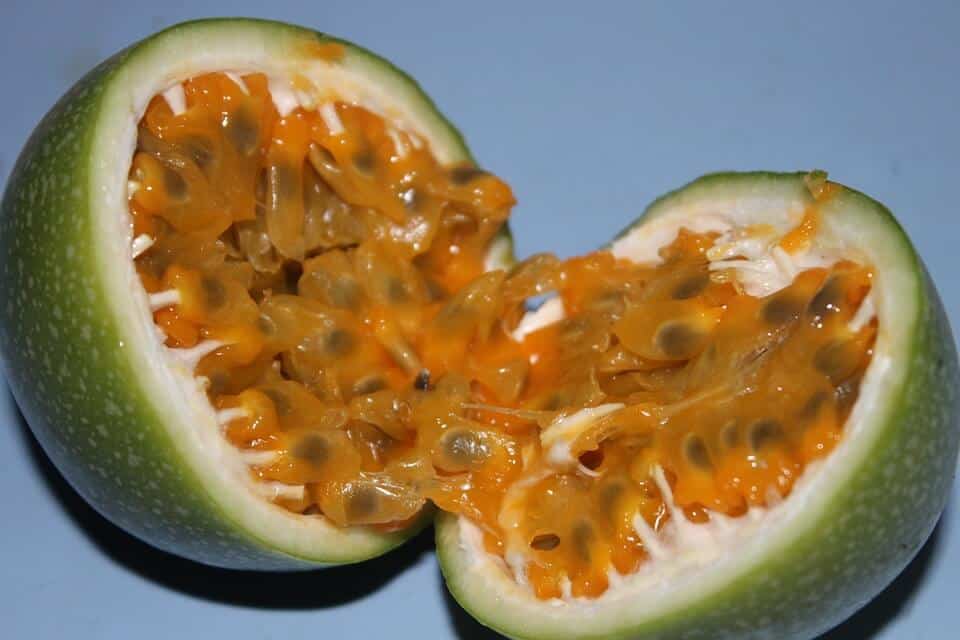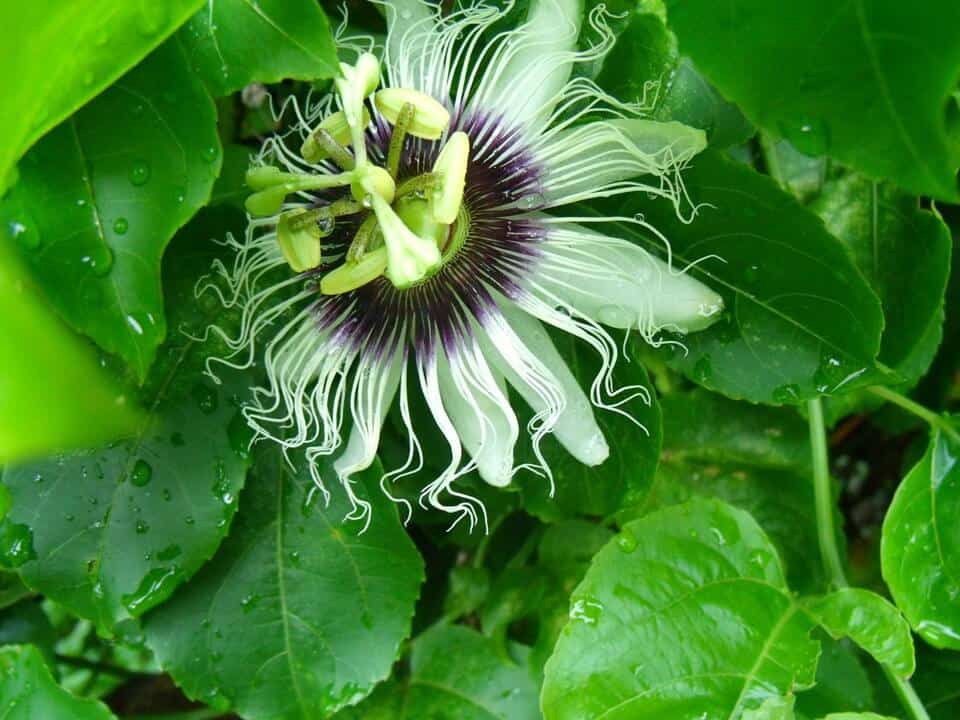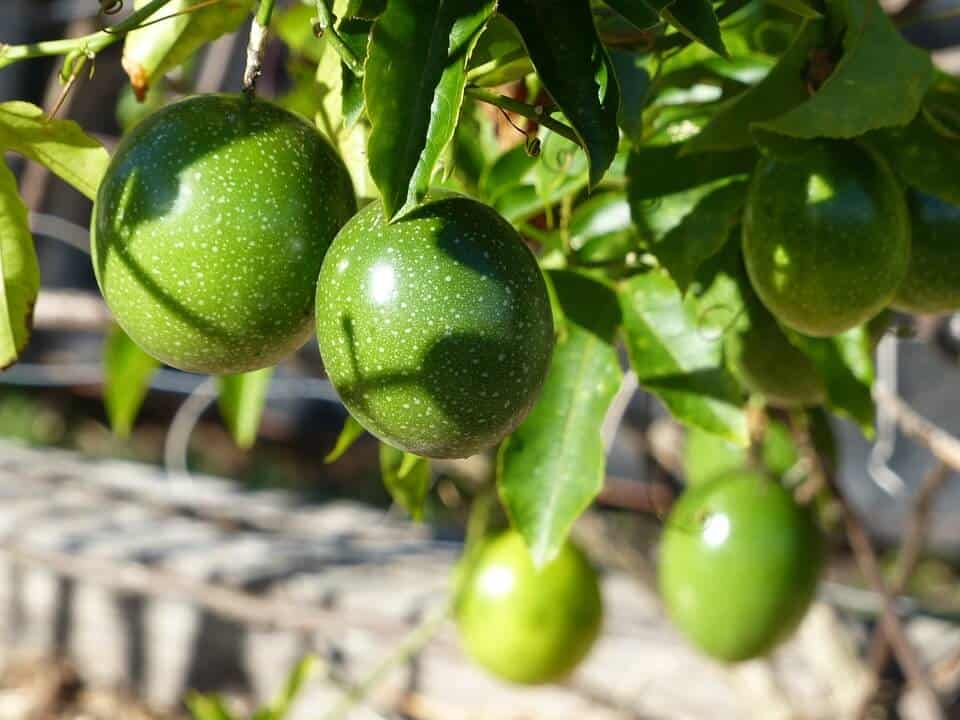Over the past few months, you may have heard some chatter about the immense benefits of growing passion fruit. Not surprising.
According to Softkenya, passion fruit is third most popular fruit in Kenya after mangoes and bananas respectively, and this enterprise already boasts an area of 6000 hectares under production.
Passion fruit is only growing in popularity as the hottest new gold mine, and that’s why in 2010, passion fruit made Hit Wise’s list of the top most lucrative fruit ventures in Kenya, currently sitting at #3 and beating out big names like papaya and avocados.

And as with any hot new enterprise that comes onto the scene, farmers and gardeners are chiming in with, “Can I use it for income generation?” “…and, how?”
The short answer? Absolutely. The longer answer? Read on to find out how.
Recommended: Download your free sample of passion fruit farming course
Growing passion fruit step by step
Passion fruit is a perennial plant that allows farmers to enjoy yields for longer periods often exceeding three years depending on management. As with most other fruits, you can intercrop passion fruit with vegetables such as leeks, onions, beetroots, spinach, strawberries and any other crop that does not share pest and diseases with the passions.
Popular cultivars include purple passion fruit and yellow passion fruit.
The purple passion fruit (Passiflora edulis f. edulis)
Suitable for areas with an altitude of 1100 to 2500m above sea level. The fruit has an aromatic flavor with a diameter of 4-5 cm.
Who are the consumers? Fresh markets and juice extractors
Purple form (Varieties)– Black night, Edgehill, Frederick, Kahuna, Paul Ecke, Purple Giant, Red Rover
Yellow passion fruit (Passiflora edulis f. flavicarpa)
Yellow passion fruit is suitable for low altitudes such as coastal lowlands. It’s more hardy and vigorous as compared to the purple passion. The fruit is bigger with a diameter of 5-7 cm, relatively acidic and used for juice extraction.
Of course, it’s also yellow, ha.
More fundamentally, yellow passion fruit is used as a rootstalk to purple passion fruit since it’s resistant to most diseases affecting the passion fruits such as Phytophthora blight, Fusarium, wilt, brown spot, and nematodes.
Yellow form – Brazilian golden, golden giant.
Related: What Most Agribusiness Experts Won’t Tell You
Soil Preparation and Planting
I’m assuming that you have already plowed and harrowed your soil to a fine texture. I’m also assuming that you have a very clear plan of your yard depending on the size of your land. Next, you need to sterilize the soil since passion fruits are very sensitive to nematodes and other disease-causing agents such as Fusarium sp.
There are several ways for you to choose from when it comes to soil sterilization
- You can use fumigation method and
- Solarisation
Of course, there are several more other ways. Please feel free to use them. In this case, I’m going to focus on one that is cheap, economical and efficient – Solarisation
How to sterilize the soil using solarisation method
- Wet the ground that you intend to grow the passions into – this ensures that the heat reaches lower horizons
- Cover the soil entirely with a polythene paper
- Leave it there for at least a week
Assumption: You have at least five to seven hours of sunshine a day.
After this period elapses, remove the polythene and inoculate the area with the beneficial microorganism. The popular brand is the EM.1 found on amazon and shipped anywhere for free by Amazon.com. This is because solarisation kills all micro-organism (both harmful and beneficial ones). I will address this topic in details in the future articles.
Good job! Your soil is now safe for growing passion fruits.
The best way to get good results is by growing your purple passion fruit from grafted seedlings. Yellow passion fruits serve as rootstalk.
Plant the seedlings at a reasonable depth and recommended spacing for your area. While doing this, ensure that the graft union is not covered by the soil to avoid rotting. Remember to water the newly planted seedlings before you call it a day.
Crop management
After 1-2 weeks, it is expected that the seedlings have acclimatized to their new environment, and therefore, you should start seeing some remarkable changes in growth. This only marks the beginning of more work to come.
And yes, it’s general crop management.
Growing passion fruits require some basic necessities; for example, feeding, and crop protection. The most important management practices will entail;
- Water application in the right proportions (Avoid under-watering or over-watering).
- Application of necessary nutrients in the form of fertilizers and foliar sprays (Always conduct periodical soil analysis to determine which nutrient elements needs supplementing). – Too much or too little nutrients might actually injure your plants.
- Periodical soil conditioning, for example, addition of compost and organic materials
- Weeding – or mulching with a polythene that suppresses weeds
- Frequent monitoring of the crop for pest and diseases and taking the necessary precautions (Use a holistic approach or Integrated Pest Management strategies to combat pest and diseases). It is also worth noting that in case you have to spray, use only recommended pesticides and observe Minimum Residue Levels (MRLs).
Related: 17 Reasons Why Your Agribusiness is Doomed!
Support and training
If you’ve done all your homework up to this point, your young plants should be growing more and more vigorously. You’ll realize this when you see dense foliage and emergence of tendrils. (Tendrils are rope-like structures used by passion vines to support themselves against other objects).

Tendrils are an indication that your plants need support. You can support your passion fruit seedlings by erecting poles and some strong ropes or wires. Personally, I’d go for meshed wires – they do an excellent job!
Once you’ve put the support structure in place, it’s time to guide the growth of those plants along the support. In a nutshell, guiding your passion seedlings to grow in the desired way is what we call training. We don’t want the fruits lying on the ground.
Maturity and Harvesting
For most beginners, this is where the dilemma starts. How do you tell when your passion fruits have matured? How do you know when to start harvesting?
You don’t have to know!
Unlike other fruits that need an understanding of maturity indices, passion fruits are different. Once they attain a proper physiological maturity, they detach from the mother plant and falls on the ground. Now, all you have to do is get a crate and pick them one by one. This can be done twice a day depending on their volume. Just make sure you don’t leave them too long on the ground.
Packing and packaging
How do present your precious produce to your consumer? The answer to this question will differentiate you from your competition. Think deeply about your brand and communicate it through your packaging. You’ve worked so hard to feed the world don’t lose the opportunity to reap big by failing to pay attention to your presentation.
Keep in mind that whatever packaging material you chose;
- It has to contain your produce
- Communicate and
- Protect your produce
The business side of growing passion fruit
Incorporating Passions into your farming venture might seem like a great opportunity for your business, but you need to make sure it’s generating results to make it worth your time and effort.
Related: How to Choose a Suitable Site for Growing Passion Fruit
Whenever possible, include a well-detailed business plan and a proper statement of inflows and outflows to give you a sense of direction.
Keep track of expenditures and income generated from your venture.
To start you off, this is how your income statement should look.
Income Statement per acre (passion fruit)
| Production system (rain-fed) | Year 1 | Year 2 | Year 3 |
| Revenue | |||
| Output (kg) Farm-gate price (KES/kg) |
7,360 30.00 |
20,200 30.00 |
15,000 30.00 |
| Gross Revenue (KES/Acre) | 220,800 | 606,000 | 450,000 |
| Cost of Production (KES) | |||
| Crop establishment | |||
| Grafted seedlings (670@40) Posts (350@150) Wires 120kgs@150 Sisal twines 110kgs@200 Planting holes 670@10 Manure 14tonnes Labour cost |
26,800 52,000 18,000 20,000 6,700 10,000 20,000 |
0.00 0.00 0.00 0.00 0.00 0.00 0.00 |
0.00 0.00 0.00 0.00 0.00 0.00 0.00 |
| Total Establishment Cost | 154,000 | 0.00 | 0.00 |
| Crop Inputs | |||
| Weeding Spraying CAN DAP/TSP 130kgs/Acre Foliar feeds Insecticides Fungicides Harvesting Other Costs |
9,000 7,750 3,200 10,400 1,250 2,450 8,450 3,500 1,660 |
9,000 7,750 6,400 2,500 2,500 3,000 8,450 3,500 2,410 |
9,000 0.00 6,400 0.00 3,150 3,000 8,450 3,500 2,150 |
| Total Crop Input Cost | 47,660 | 45,150 | 35,650 |
| Total Costs of Production | 201,660 | 45,150 | 35,650 |
| Profit (KES/Acre) | 19,140 | 560,850 | 414,350 |
| Cost of production (KES/Kg) | 10.56 | 4.01 | 4.96 |
| Margins (KES/Kg) | 2.60 | 25.99 | 25.04 |
Related: How to Export Fresh Produce from Kenya
Conclusion
You have learned how growing passion fruit can be an excellent income generator in the long run.
As you have seen, an acre can give you close to KES 1,000,000 ($10,000) in 3 years. But depending on your ability to follow the due process and all the recommendations, the results can be varied.
I have done my part and guarantee that growing passion fruit for money is not only a hype but a genuine agribusiness. Now it’s your turn to give it a try and thank me later.

Hello Chris,
This is a another great article that has really motivated me. Will for sure try out growing passion fruit as a side venture and see how it goes.
Once again thanks for sharing. I’m definitely sharing this with my friends.
Lydia
Thank you for your kind words. I always strive to give you more actionable farming information and I’m glad you’ve considered taking action. Let me know how it goes.
this article is giving me a murder boner
And what about markets? I am a farmer and to grow crop is possible as there is a wealth of information in books, web, experts, etc…. I grow cereals, avocados and deal in livestock. The biggest issue is market! At times there is a market but many a time i have found the product sitting in storage till it gets to a point you will sell for anything! Affecting your bottom line period!
Hey Whereisdmarket,
I love your sentiments. But I’m also curious to know why you’re growing cereals, avocados etc. I think enterprise selection should be first based on market availability.
I believe that just growing stuff for the sake of it without being driven by demand is a waste of time and resources.
Check out these articles for more information;
What Most Agribusiness Experts Won’t Tell You
17 Reasons Why Your Agribusiness is Doomed!
Hey Chris,
Thanks for your response. I wish to respond as an actual farmer. Yes cereals today not a great market due to oversupply in last 2 years worldwide. This thus brings locally higher quality wheat for our market down, our inputs have actually escalated. Now Avocados, that is a 4 year ROI, 4 years ago the market was great again. We started with looking for markets and by golly there was a market. Second step was to study, learn, read, talk to an array of experts, local and overseas growers, look into varieties etc….. Finally land acquired, prepped, planted and nurtured to all studied and attained best practises. Harvest is now in sight and the market that was 4 years ago is not as good. So on paper as a business the figures do not tally! Agriculture is an expensive venture that has always been a way of seeing a lucrative future.
Whereisdmarket, to some extent your arguments are valid and reflects a true picture of the reality on the ground.
From my experience as a farmer, continuous market research and diversification is key rather than treating marketing as a preliminary one time event.
Because as you’ve correctly mentioned, demand change with time and as such, so should the market strategy.
Other non-Agricultural businesses do this all the time. They operate on the principle of continuous improvement to net in more customers for their business.
One problem with most farmers, and I’m happy you’re not one of them, is that of negligence. They make decisions based on assumptions and failure to invest in marketing. And if they do, they fail to validate their market beyond common sense.
If farming can be treated as other serious businesses with fully fledged departments and budget, the odds of success and getting a better ROI will be guaranteed.
We can discuss more if you want. Just get in touch and we’ll pick it from there.
Hallo am looking for recomendation for organic certified products to used in farming more so passion fruits.Any lead i will apreciate.My email [email protected]